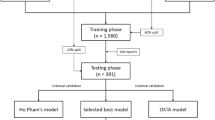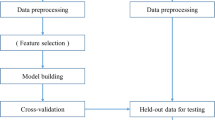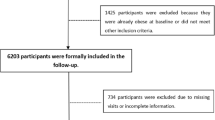Abstract
Lead is one of the most hazardous environmental pollutants in industrialized countries; lead exposure is a risk factor for osteoarthritis (OA) in older women. Here, the performance of several machine-learning (ML) algorithms in terms of predicting the prevalence of OA associated with lead exposure was compared. A total of 2224 women aged 50 years and older who participated in the Korea National Health and Nutrition Examination Surveys from 2005 to 2017 were divided into a training dataset (70%) for generation of ML models, and a test dataset (30%). We built and tested five ML algorithms, including logistic regression (LR), a k-nearest neighbor model, a decision tree, a random forest, and a support vector machine. All afforded acceptable predictive accuracy; the LR model was the most accurate and yielded the greatest area under the receiver operating characteristic curve. We found that various ML models can be used to predict the risk of OA associated with lead exposure effectively, using data from population-based survey.


Similar content being viewed by others
Data availability
The data that support the findings of this study are available from the corresponding author upon reasonable request.
References
Abbott JH, Usiskin IM, Wilson R, Hansen P, Losina E (2017) The quality-of-life burden of knee osteoarthritis in New Zealand adults: a model-based evaluation. PLoS One 12:e0185676
Battineni G, Sagaro GG, Chinatalapudi N, Amenta F (2020) Applications of machine learning predictive models in the chronic disease diagnosis. J Pers Med 10:21
Choi YH, Park SK (2017) Environmental exposures to lead, mercury, and cadmium and hearing loss in adults and adolescents: KNHANES 2010-2012. Environ Health Perspect 125:067003
Counter SA, Buchanan LH, Ortega F (2005) Neurocognitive impairment in lead-exposed children of Andean lead-glazing workers. J Occup Environ Med 47:306–312
Farzan SF, Howe CG, Chen Y, Gilbert-Diamond D, Cottingham KL, Jackson BP, Weinstein AR, Karagas MR (2018) Prenatal lead exposure and elevated blood pressure in children. Environ Int 121:1289–1296
Frank JJ, Poulakos AG, Tornero-Velez R, Xue J (2019) Systematic review and meta-analyses of lead (Pb) concentrations in environmental media (soil, dust, water, food, and air) reported in the United States from 1996 to 2016. Sci Total Environ 694:133489
Galatzer-Levy IR, Ma S, Statnikov A, Yehuda R, Shalev AY (2017) Utilization of machine learning for prediction of post-traumatic stress: a re-examination of cortisol in the prediction and pathways to non-remitting PTSD. Transl Psychiatry 7:e1070
Harari F, Barregard L, Östling G, Sallsten G, Hedblad B, Forsgard N, Borné Y, Fagerberg B, Engström G (2019) Blood lead levels and risk of atherosclerosis in the carotid artery: results from a Swedish cohort. Environ Health Perspect 127:127002
Holz JD, Beier E, Sheu TJ, Ubayawardena R, Wang M, Sampson ER, Rosier RN, Zuscik M, Puzas JE (2012) Lead induces an osteoarthritis-like phenotype in articular chondrocytes through disruption of TGF-beta signaling. J Orthop Res 30:1760–1766
Hu H, Aro A, Payton M, Korrick S, Sparrow D, Weiss ST, Rotnitzky A (1996a) The relationship of bone and blood lead to hypertension: the Normative Aging Study. JAMA 275:1171–1176
Hu H, Payton M, Korrick S, Aro A, Sparrow D, Weiss ST, Rotnitzky A (1996b) Determinants of bone and blood lead levels among community-exposed middle-aged to elderly men. Am J Epidemiol 144:749–759
Kim JH, Kang JC (2015) The lead accumulation and hematological findings in juvenile rock fish Sebastes schlegelii exposed to the dietary lead (II) concentrations. Ecotoxicol Environ Saf 115:33–39
Kim R, Rotnitsky A, Sparrow D, Weiss S, Wager C, Hu H (1996) A longitudinal study of low-level lead exposure and impairment of renal function: the Normative Aging Study. JAMA 275:1177–1181
LeCun Y, Bengio Y, Hinton G (2015) Deep learning. Nature 521:436–444
Litwic A, Edwards MH, Dennison EM, Cooper C (2013) Epidemiology and burden of osteoarthritis. Br Med Bull 105:185–199
Manolagas SC (2000) Birth and death of bone cells: basic regulatory mechanisms and implications for the pathogenesis and treatment of osteoporosis. Endocr Rev 21:115–137
Martini CN, Gabrielli M, Bonifacino G, Codesido MM, Vila MDC (2018) Lead enhancement of 3T3-L1 fibroblasts differentiation to adipocytes involves ERK, C/EBPβ and PPARγ activation. Mol Cell Biochem 437:37–44
Meng Q, Richmond-Bryant J, Davis JA, Cohen J, Svendsgaard D, Brown JS, Tuttle L, Hubbard H, Rice J, Vinikoor-Imler L, Sacks JD, Kirrane E, Kotchmar D, Hines E, Ross M (2014) Contribution of particle-size-fractionated airborne lead to blood lead during the National Health and Nutrition Examination Survey, 1999-2008. Environ Sci Technol 48:1263–1270
Miao H, Liu Y, Tsai TC, Schwartz J, Ji JS (2020) Association between blood lead level and uncontrolled hypertension in the US population (NHANES 1999-2016). J Am Heart Assoc 9:e015533
Nash D, Magder L, Lustberg M, Sherwin RW, Rubin RJ, Kaufmann RB, Silbergeld EK (2003) Blood lead, blood pressure, and hypertension in perimenopausal and postmenopausal women. JAMA 289:1523–1532
Nelson AE, Shi XA, Schwartz TA, Chen JC, Renner JB, Caldwell KL, Helmick CG, Jordan JM (2011a) Whole blood lead levels are associated with radiographic and symptomatic knee osteoarthritis: a cross-sectional analysis in the Johnston County Osteoarthritis Project. Arthritis Res Ther 13:R37
Nelson AE, Chaudhary S, Kraus VB, Fang F, Chen JC, Schwartz TA, Shi XA, Renner JB, Stabler TV, Helmick CG, Caldwell K, Poole AR, Jordan JM (2011b) Whole blood lead levels are associated with biomarkers of joint tissue metabolism in African American and white men and women: the Johnston County Osteoarthritis Project. Environ Res 111:1208–1214
Olchowik G, Widomska J, Tomaszewski M, Gospodarek M, Tomaszewska M, Jagiełło-Wójtowicz E (2014) The influence of lead on the biomechanical properties of bone tissue in rats. Ann Agric Environ Med 21:278–281
Park S, Choi NK (2019) The relationships of blood lead level, body mass index, and osteoarthritis in postmenopausal women. Maturitas 125:85–90
Patrick L (2006) Lead toxicity, a review of the literature. Part I: Exposure, evaluation, and treatment. Altern Med Rev 11:2–22
Payton M, Riggs KM, Spiro A 3rd, Weiss ST, Hu H (1998) Relations of bone and blood lead to cognitive function: the VA Normative Aging Study. Neurotoxicol Teratol 20:19–27
Pirkle JL, Brody DJ, Gunter EW, Kramer RA, Paschal DC, Flegal KM, Matte TD (1994) The decline in blood lead levels in the United States: the National Health and Nutrition Examination Surveys (NHANES). JAMA 272:284–291
Safiri S, Kolahi AA, Smith E, Hill C, Bettampadi D, Mansournia MA, Hoy D, Ashrafi-Asgarabad A, Sepidarkish M, Almasi-Hashiani A, Collins G, Kaufman J, Qorbani M, Moradi-Lakeh M, Woolf AD, Guillemin F, March L, Cross M (2020) Global, regional and national burden of osteoarthritis 1990-2017: a systematic analysis of the Global Burden of Disease Study 2017. Ann Rheum Dis 79:819–828
Sniekers YH, Intema F, Lafeber FP, van Osch GJ, van Leeuwen JP, Weinans H, Mastbergen SC (2008) A role for subchondral bone changes in the process of osteoarthritis; a micro-CT study of two canine models. BMC Musculoskelet Disord 9:20
Sniekers YH, Weinans H, van Osch GJ, van Leeuwen JP (2010) Oestrogen is important for maintenance of cartilage and subchondral bone in a murine model of knee osteoarthritis. Arthritis Res Ther 12:R182
Sommar JN, Hedmer M, Lundh T, Nilsson L, Skerfving S, Bergdahl IA (2014) Investigation of lead concentrations in whole blood, plasma and urine as biomarkers for biological monitoring of lead exposure. J Expo Sci Environ Epidemiol 24:51–57
Talukder A, Ahammed B (2020) Machine learning algorithms for predicting malnutrition among under-five children in Bangladesh. Nutrition 78:110861
Tchounwou PB, Yedjou CG, Patlolla AK, Sutton DJ (2012) Heavy metal toxicity and the environment. Exp Suppl 101:133–164
Webber CE, Chettle DR, Bowins RJ, Beaumont LF, Gordon CL, Song X, Blake JM, McNutt RH (1995) Hormone replacement therapy may reduce the return of endogenous lead from bone to the circulation. Environ. Health Perspect 103:1150–1153
Weitzmann MN, Pacifici R (2006) Estrogen deficiency and bone loss: an inflammatory tale. J Clin Invest 116:1186–1194
Zhang X, Yuan Z, Ji J, Li H, Xue F (2016) Network or regression-based methods for disease discrimination: a comparison study. BMC Med Res Methodol 16:100
Funding
This research was supported by the Keimyung University Research Grant of 2019.
Author information
Authors and Affiliations
Contributions
K.K. contributed to conceptualization, data analysis and interpretation, and supervision of the study. H.P. contributed to design of the study, algorithm analysis, and drafting of the manuscript. All authors have read and agreed to the final manuscript.
Corresponding author
Ethics declarations
Ethics approval and consent to participate
The KNHANES received approval from the KNHANES Institutional Review Board (IRB approval # 2010-02CON-21-C), and written informed consent was obtained from all participants.
Consent for publication
Not applicable.
Conflict of interest
The authors declare no competing interests.
Additional information
Responsible Editor: Lotfi Aleya
Publisher’s note
Springer Nature remains neutral with regard to jurisdictional claims in published maps and institutional affiliations.
Rights and permissions
About this article
Cite this article
Kim, K., Park, H. Machine-learning models predicting osteoarthritis associated with the lead blood level. Environ Sci Pollut Res 28, 44079–44084 (2021). https://doi.org/10.1007/s11356-021-13887-6
Received:
Accepted:
Published:
Issue Date:
DOI: https://doi.org/10.1007/s11356-021-13887-6




